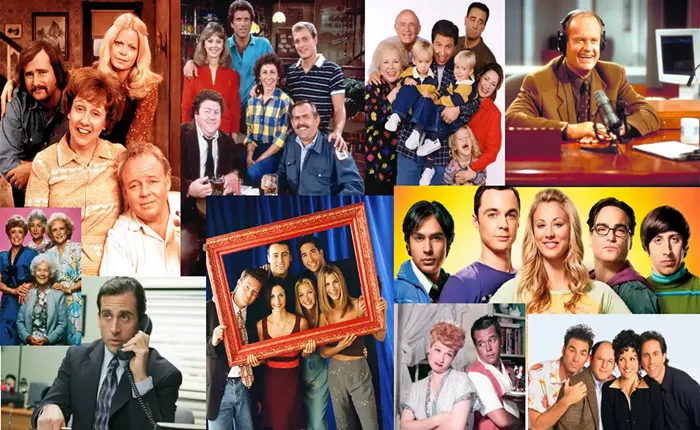A television sitcom, short for “situation comedy,” is a genre of comedy programming that originated in radio and later transitioned to television. Sitcoms typically feature a recurring cast of characters who navigate humorous situations in a shared environment, such as a home, workplace, or neighborhood. The format often includes episodic storylines, with conflicts resolved by the end of each episode, and is marked by its use of verbal wit, physical comedy, and situational humor.
Sitcoms are usually 30 minutes long, making them ideal for prime-time television slots. They are often filmed in front of a live studio audience or use canned laughter to enhance the comedic effect. The genre has evolved over the decades, adapting to cultural changes and audience preferences, but its core elements remain consistent.
What is Television Sitcom
Early Beginnings
The first sitcom, Pinwright’s Progress, aired on the BBC in 1946. However, it was the American sitcom I Love Lucy (1951–1957) that truly popularized the genre. I Love Lucy introduced many conventions still used today, such as the three-camera setup and the inclusion of a live audience.
The Golden Age
The 1970s and 1980s are often referred to as the “Golden Age” of sitcoms. Shows like All in the Family, The Mary Tyler Moore Show, and Cheers tackled social issues while maintaining their comedic appeal. These sitcoms were groundbreaking in their ability to blend humor with commentary on topics like race, gender, and politics.
Modern Era
In the 1990s and 2000s, sitcoms like Friends, Seinfeld, and The Office redefined the genre. These shows focused on the lives of young adults and workplace dynamics, resonating with a new generation of viewers. More recently, sitcoms like The Big Bang Theory and Brooklyn Nine-Nine have continued to innovate, incorporating diverse characters and modern themes.
Key Elements of a Sitcom
Recurring Characters
One of the defining features of a sitcom is its cast of recurring characters. These characters often have distinct personalities and quirks, which create the foundation for the show’s humor. For example, in Friends, the characters’ unique traits—such as Chandler’s sarcasm and Joey’s dim-witted charm—drive much of the comedy.
Situational Humor
Sitcoms derive much of their humor from the situations the characters find themselves in. These situations are often exaggerated or absurd, leading to comedic misunderstandings or conflicts. For instance, in The Office, the mundane setting of a paper company becomes the backdrop for hilarious workplace antics.
Episodic Structure
Most sitcoms follow an episodic structure, meaning each episode is self-contained, with a clear beginning, middle, and end. This format allows viewers to jump in at any point without needing to follow a continuous storyline. However, some modern sitcoms, like How I Met Your Mother, incorporate serialized elements to keep audiences engaged over multiple seasons.
Popular Sitcoms Through the Decades
Classic Sitcoms
I Love Lucy (1951–1957): A pioneering sitcom that set the standard for the genre.
The Honeymooners (1955–1956): Known for its iconic characters and timeless humor.
All in the Family (1971–1979): A groundbreaking show that addressed social issues with humor.
1990s and 2000s Sitcoms
Friends (1994–2004): A cultural phenomenon that followed the lives of six friends in New York City.
Seinfeld (1989–1998): Often described as “a show about nothing,” it became one of the most influential sitcoms of all time.
The Office (2005–2013): A mockumentary-style sitcom that redefined workplace comedy.
Modern Sitcoms
The Big Bang Theory (2007–2019): A sitcom centered around a group of socially awkward scientists.
Brooklyn Nine-Nine (2013–2021): A police procedural sitcom known for its diverse cast and progressive themes.
Parks and Recreation (2009–2015): A mockumentary-style sitcom that focused on local government employees.
The Cultural Impact of Sitcoms
Sitcoms have had a profound impact on popular culture, influencing everything from fashion to language. Shows like Friends and Seinfeld introduced catchphrases that became part of everyday conversation, while The Office inspired a new wave of mockumentary-style programming.
Moreover, sitcoms have served as a mirror to society, reflecting and sometimes challenging societal norms. For example, All in the Family tackled issues like racism and sexism, while Modern Family explored the complexities of contemporary family structures.
Conclusion
Television sitcoms are a beloved and enduring genre that continues to evolve with the times. From their early beginnings in radio to their current status as a staple of modern entertainment, sitcoms have consistently provided audiences with laughter, relatability, and cultural commentary. Whether it’s the timeless humor of I Love Lucy or the modern wit of Brooklyn Nine-Nine, sitcoms remain a vital part of the television landscape.

